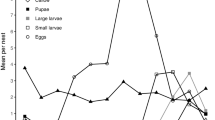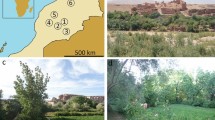Summary
The life cycle and aspects of the social organization ofExoneura bicolor are described for the first time. The population studied was univoltine, with egg production occuring from late winter through to early summer. Throughout the year most nests are occupied by more than one female, and most new nests are initiated by groups of up to 6 cofoundresses. Reproductive differentiation between nestmates is very pronounced during winter, with only one or two egg-layers in each nest. These females appear to be largely responsible for maintaining their adult nestmates in Autumn. In spring, additional females are inseminated and begin to lay eggs, though some remain unmated and do not show ovarian enlargement. New nests are founded during late spring, and most foundresses are mated and have enlarged ovaries. Relatedness between nestmates was estimated using a polymorphic enzyme regression technique, and was found to be similar for both overwintered and co-founded nests, suggesting that co-foundresses originate from the same natal nests. The consequences of persistant multi-female nests and reproductive differentiation are discussed, and it is suggested that terms such as ‘eusocial’ and ‘semisocial’ are inappropriate to describe even ontogenetic stages in allodapine colony development.
Zusammenfassung
Lebenszyklus und Aspekte der sozialen Organisation vonExoneura bicolor werden erstmalig beschrieben. Die untersuchte Population war univoltin, wobei die Eiproduktion vom späten Winter bis zum Frühsommer stattfand. Das ganze Jahr hindurch enthalten die meisten Nester mehr als ein Weibchen, und die meisten Nester werden auch durch Gruppen von bis zu 6 Weibchen gegründet. Eine reproduktive Differenzierung zwischen Nestgenossinnen ist im Winter sehr ausgeprägt, mit nur einer oder zwei Eierlegerinnen in jedem Nest. Diese Weibchen scheinen hauptsächlich für die Erhaltung ihrer adulten Nestgenossinnen im Herbst verantwortlich zu sein. Im Frühling werden weitere Weibchen begattet und beginnen Eier zu legen, obwohl einige unbegattet bleiben und keine Ovarvergrößerung aufweisen. Neue Nester werden im Spätfrühling gegründet. Gründerinnen sind begattet und haben vergrößerte Ovarien. Die Verwandtschaft der Nestinsassen wurde mittels eines Regressionsverfahrens für polymorphe Enzyme bestimmt. Sie war ählich in überwinterten wie auch neu gegründeten Nestern. Dies deutt an, daß die Nestgründerinnen jeweils aus demselben Mutternest stammen. Die Konsequenzen aus dem Fortbestehen polygyner Nester und der reproduktiven Differenzierung werden erörtert. Es wird dargelegt, daß Bezeichnungen wie “eusozial” und “semi-sozial” nicht geeignet sind um ontogenetische Stadien in der Entwicklung von Allodapinen-Kolonien zu beschreiben.
Similar content being viewed by others
References
Andersson M., 1984. — The evolution of eusociality.Ann. Rev. Ecol. Sys., 15, 165–189.
Cane J.H., Michener C.D., 1983. — Chemistry and function of mandibular gland products of bees of the genusExoneura (Hymenoptera, Anthophoridae).J. Chem. Ecol., 9, 1525–1532.
Houston T.F., 1976. — New Australian allodapine bees (subgenusExoneurella Michener) and their immatures (Hymenoptera: Anthophoridae).Trans. R. Soc. S. Aust, 100, 15–28.
Houston T.F., 1977. — Nesting biology of three allodapine bees in the subgenusExoneurella Michener (Hymenoptera, Anthophoridae).Trans. R. Soc. S. Aust., 101, 99–113.
Hull C.H., Nie N.H., 1981. — SPSS update 7-9. McGraw-Hill, New York,xix-402 pp.
Maeta Y., Sakagami S.F., Michener C.D. 1985. — Laboratory studies on the life cycle and nesting biology ofBraunsapis sauteriella, a social Xylocopine bee.J. Sociobiol., 10, 17–41.
Michener C.D., 1965a. — The life cycle and social organization of bees of the genusExoneura and their parasiteInquilina (Hymenoptera: Xylocopinae).Univ. Kansas Sci. Bull., 46, 317–358.
Michener C.D., 1965b. — A classification of the bees of the Australian and South Pacific regions.Bull. Am. Mus. Nat. Hist., 130, 1–362.
Michener C.D., 1971. — Biologies of African allodapine bees (Hymenoptera, Xylocopinae).Bull. Dm. Mus. Nat. Hist., 145, 219–302.
Michener C.D., 1974. —The social behaviour of the bees.Harvard University Press, Cambridge, Mass.xii-404 pp.
Michener C.D., 1983. — The parasitic Australian genusInquilina (Hymenoptera, Anthophoridae).J. Kansas Entom. Soc., 56, 555–559.
Pamilo P., 1984. — Genetic relatedness and evolution of insect sociality.Behav. Ecol. Sociobiol., 15, 241–248.
Pamilo P., Crozier R.H., 1982. — Measuring genetic relatedness in natural populations: methodology.Theor. Pop. Biol., 21, 171–193.
Poulik M.D., 1957. — Starch gel electrophoresis in a discontinuous system of buffers.Nature, 180, 1477–1490.
Sakagami S.F., 1960. — Ethological peculiarities of the primitive social bees,Allodape Lepeltier [sic] and allied genera.Ins. Soc., 7, 231–249.
Schwarz M.P., 1982. — Life cycle and social organization in the allodapine beeExoneura (Exoneura) bicolor Smith. Unpublished B. Sc. (Hons.) thesis. Monash University, Clayton, Australia,iv-106 pp.
Schwarz M.P.,in prep. — Co-foundressing in allodapine bees — a correlate of communal rearing.
Shaw R.S., Prasad R., 1970. — Starch gel electrophoresis of enzymes — a compilation of recipes.Biochem. Genet., 4, 297–320.
Siegel S., 1956. —Nonparametric statistics: for the behavioural sciences. McGraw-Hill, New York,ix-312 pp.
Wilson E.O., 1971. —The insect societies. Belknap Press of Harvard University Press, Cambridge, Mass.
Author information
Authors and Affiliations
Rights and permissions
About this article
Cite this article
Schwarz, M.P. Persistent multi-female nests in an Australian allodapine bee,Exoneura bicolor (Hymenoptera, Anthophoridae). Ins. Soc 33, 258–277 (1986). https://doi.org/10.1007/BF02224245
Received:
Accepted:
Issue Date:
DOI: https://doi.org/10.1007/BF02224245




